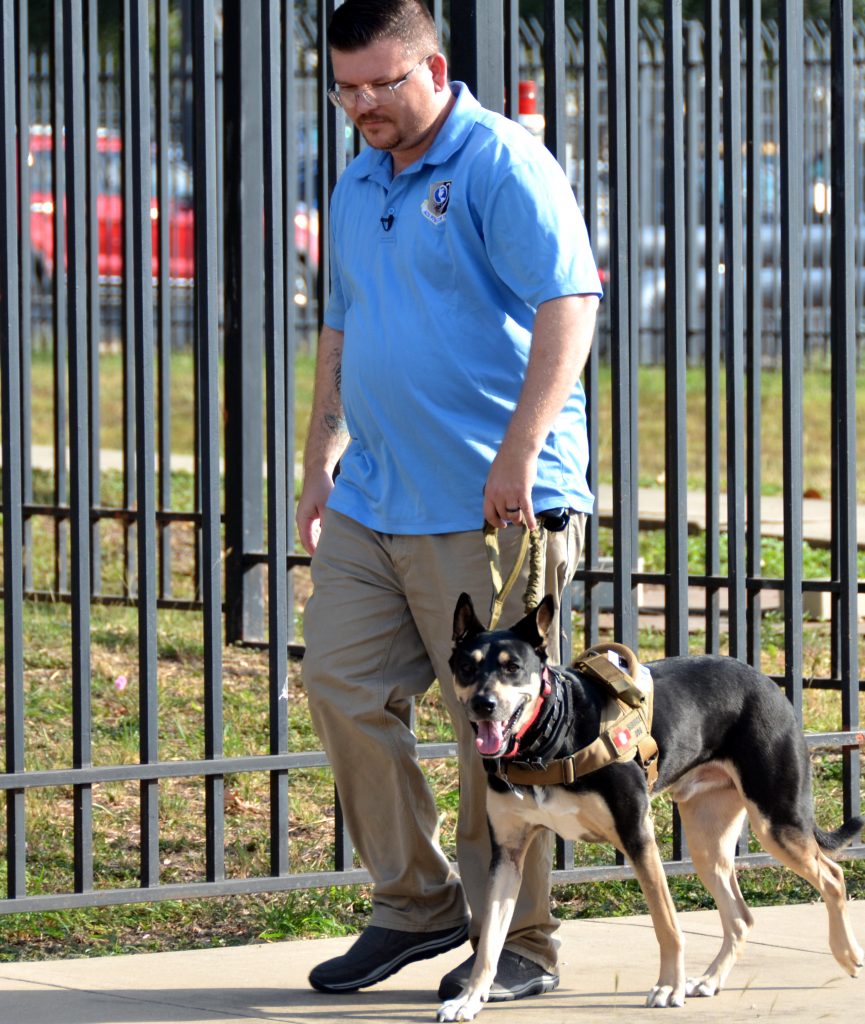Many pet owners are unfamiliar with the differences between service animals (SAs), emotional support animals (ESAs), and therapy animals (TAs). Many also attempt to skirt laws by inaccurately claiming their pet is an ESA in an effort to save a buck. So, this week I wanted to dedicate some blog space to differentiating them, to shedding a light on this important topic. I hope you find the information enlightening! Happy reading.

What is a service animal?
A service animal – as defined by the Americans with Disabilities Act (ADA) – is a dog “that has been individually trained to do work or perform tasks for an individual with a disability. That’s right! As of 15 March 2011, only dogs are recognized as service animals under Title II and III of the ADA. Any breed of dog may be service animal.
Revised ADA regulations do recognize miniature horses that have been individually trained to do work or perform tasks for people with disabilities. These animals are not included in the definition of service animal. However, businesses must make reasonable modifications in policies, practices, or procedures to permit the use of a miniature horse by an individual with a disability if the miniature horse has been individually trained to do work or perform tasks for the benefit of the individual with a disability.
Factors to assist in determining whether miniature horses can be accommodated are:
- The miniature horse is housebroken
- The miniature horse is under the owner’s control
- The facility can accommodate the miniature horse’s type, size, and weight
- The miniature horse’s presence will not compromise legitimate safety requirements necessary for the safe operation of the facility
Where can a service animal go?
Service animals must be allowed to accompany disabled individuals in all areas where members of the public are allowed to go. The task(s) performed by the dog must be directly related to the person’s disability. Examples of such work or tasks include:
- Guiding people who are blind
- Alerting people who are deaf
- Pulling a wheelchair
- Alerting & protecting a person who is having a seizure
- Reminding a person with mental illness to take prescribed medications
- Calming a person with post-traumatic stress disorder (PTSD) during an anxiety attack
- Alerting an individual when their blood glucose/sugar level is too low

Does a service animal require any certification?
People with disabilities have the right to train their dog themselves. The ADA does not stipulate SAs must be professionally trained. The ADA does not recognize service animals-in-training as SAs. Some local and state laws, however, do cover SAs in training. There are some organizations that “sell” SA certification and registration documents online. These documents do NOT convey any rights under the ADA, and the Department of Justice does NOT recognize them as proof a dog is a service animal.
Can someone ask an individual what their SA does?
Employees of any business – public or private – may ask only two questions of an individual with a SA if it’s not obvious what service an animal provides:
- Is the dog a service animal required because of a disability?
- What work or task has the dog been trained to perform?
Staff can’t ask about a person’s disability, require medical documentation, require a special identification card or training documentation for the dog, or ask the dog to demonstrate its ability to perform the work or task. With all this being said, members of the public can ask an individual with a SA anything they want. The hope is such individuals are respectful and don’t escalate their inquiries to the point of harassment.
Does every business and organization have to comply with the ADA?
The simple answer is no. Religious institutions are specifically exempt from the ADA. However, there may be state laws that apply to them. Federal agencies and commercial airlines do not have to comply with the ADA. Rather, the former must comply with Section 504 of the Rehabilitation Act of 1973 and the latter must comply with the Air Carrier Access Act (ACAA). For more information about the ACAA, click here.
What is an emotional support animal?
Emotional support animals support animals provide companionship, relieve loneliness, and sometimes help with depression, anxiety, and certain phobias. They must be prescribed by licensed mental health professionals to a person with a disabling mental illness. In other words, a therapist / psychologist / psychiatrist must decide the presence of the animal is needed for the mental health of the patients. Even though some states have laws defining ESAs, these animals are not limited to working with people with disabilities and therefore are not covered by federal laws protecting the use of service animals.

The key difference between SAs and ESAs is the former are trained to perform a specific task or job directly related to the person’s disability and the latter have not. For example, alerting a hearing-impaired person to an alarm or guiding a visually impaired person around an obstacle are jobs performed by SAs. Behaviors such as cuddling on cue – although comforting – would not qualify. Tasks must be specifically trained, not something instinctive dogs would do anyway.
We should mention psychiatric service dogs. These are dogs that work specifically with people whose disabilities are due to mental illness. These dogs detect the beginning of psychiatric episodes and help ease their effects. Although this sounds similar to the role of ESAs, the difference is psychiatric service dogs are trained for their roles (and thus protected by the ADA) and ESAs are not.
Are people with ESAs protected by the ADA?
The simple answer is no. The ADA does not cover emotional support animals. However, they do have some rights in terms of housing and air travel. Emotional support animals are covered by the Fair Housing Act (FHA) as assistance animals. Learn more about the FHA here. Specifically, individuals cannot be discriminated against due to a disability when obtaining housing. Emotional support animals are not pets according to the United States Department of Housing and Urban Development (HUD), the agency that oversees the FHA and investigates claims of housing discrimination. There are only two questions HUD says a housing provider should consider with a request for an ESA as a reasonable accommodation:
- Does the person seeking to use and live with the animal have a disability?
- Does the person making the request have a disability-related need for an assistance animal?
A “no” answer to either of the questions means that a housing provider is not obligated to make a reasonable accommodation according to HUD. This may mean the person does not meet the definition of disability or the ESA does not help with symptoms of the disability. If the answer is “yes” to both, then HUD states the FHA requires an exception to a “no pets” rule. The emotional support animal must alleviate or help some symptom(s) of the disability. Rules such as no pets, species bans, or pet-size limitations do not apply to people who have a prescription for an ESA. Furthermore, they cannot be charged a pet deposit for having their ESA live with them.

The Air Carrier Access Act allows service animals and ESAs to accompany their handler in the cabin of an aircraft. Individual airlines may require documentation stating the person has a disability and the reason why the animal must travel with them. If one intends to travel with an ESA, one is strongly encouraged to contact the airline ahead of time to ensure one can provide the appropriate paperwork. While SAs can only be dogs, ESAs can be of any species. To qualify, the animal must be reasonably well-behaved by typical pet standards, such as being toilet trained, and can’t be a nuisance or danger to others. Of course, airlines require a prescription from a mental health professional, and because ESAs are not protected by the ADA, airline employees can ask individuals more questions and require documentation of an ESAs legitimacy.
Why do some people have issues with ESAs?
I don’t think most reasonable people have any issues with legitimate ESAs. I suspect they have issues with some individuals with illegitimate ESAs who don’t think the rules apply to them. An increasing number of people try to cheat the system by claiming they have ESAs simply to save money, to avoid airline fees and/or pet deposit fees. They purchase bogus online documents and try to skirt the rules. Indeed, the United States government does not recognize any certification process for ESAs. Pet owners are warned not to be tricked into buying bogus certifications from online outfits like CertaPet. If one wants their ESA to be legal and legitimate, one must obtain a valid prescription from a mental health care provider.
What is a therapy animal?
Therapy animals are used in facilities to comfort people and give affection. Spending time with therapy animals has been shown to lower blood pressure and heart rate, reduce anxiety, and increase endorphins and oxytocin. Therapy dogs do not have to be trained to perform specific tasks like service dogs. Those who have passed a therapy evaluation are only allowed in locations where therapy work is approved.

Therapy animals are not protected by the ADA, FHA, or ACAA. They’re NOT allowed in all public locations. If stores, hotels, or other locations don’t allow animals, then therapy animals are also not allowed there. They don’t have any special privileges in public, for flying on airplanes, and/or for special exceptions in housing. Depending on the requirements for the location where therapy work is being provided, therapy animals typically need to pass an evaluation to demonstrate they and their handlers are able to successfully and safely provide therapy work.
Can you pass the quiz?
Q: What kind of dog can help a person when they experience social anxiety while flying?
A: Emotional support dog
Q: What kind of dog is needed at school to help children experiencing anxiety?
A: Therapy dog
Q: What kind of dog may be needed to pull a wheelchair?
A: Service dog
Q: What kind of dog is needed to remind a person with mental illness to take their prescription?
A: Service dog
Q: What kind of dog works with numerous people?
A: Therapy dog
The take-away message about SAs and ESAs…
Service animals are dogs that have been specifically trained to help an individual with a disability and are protected by ADA. Therapy animals are trained to work in various facilities to comfort people and give affection. Emotional support animals may be of any species and have been prescribed by a licensed mental health professional. Although not protected by the ADA, they do have some protected rights under the FHA and ACAA. Pet owners should respect current laws and not violate the system by pretending to have ESAs just to save a buck!
Wishing you wet-nosed kisses,







